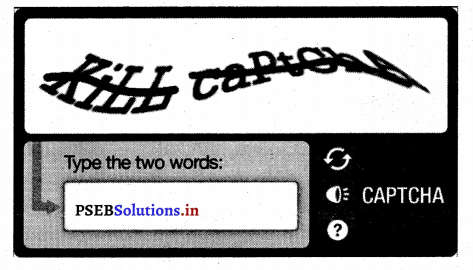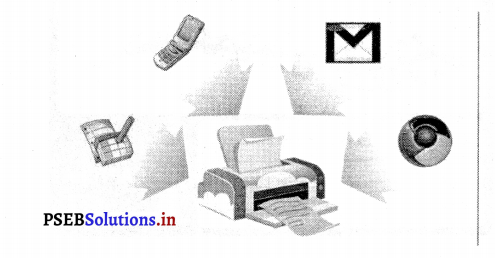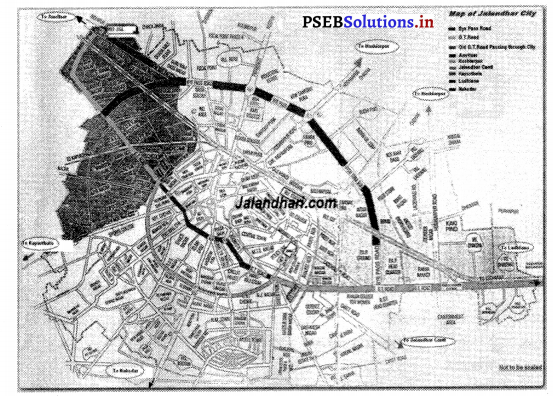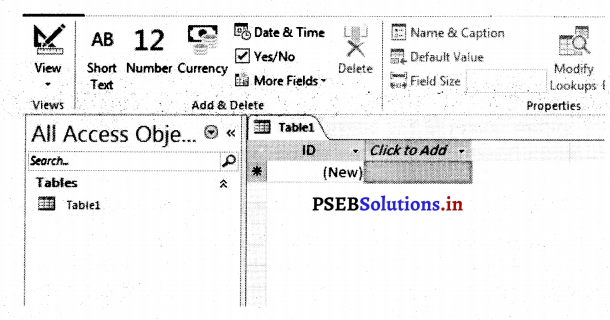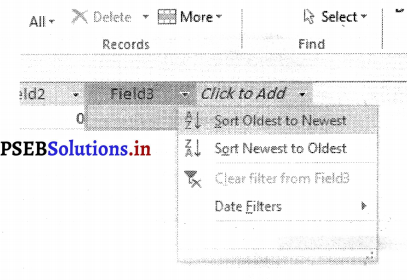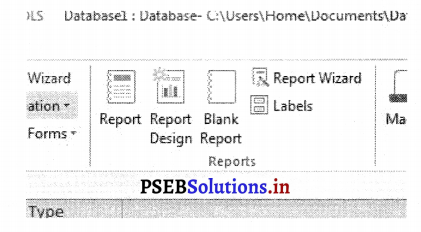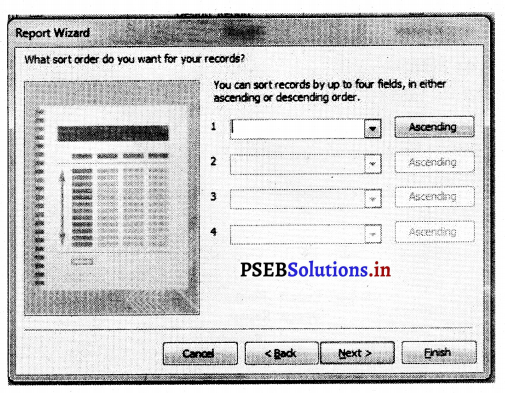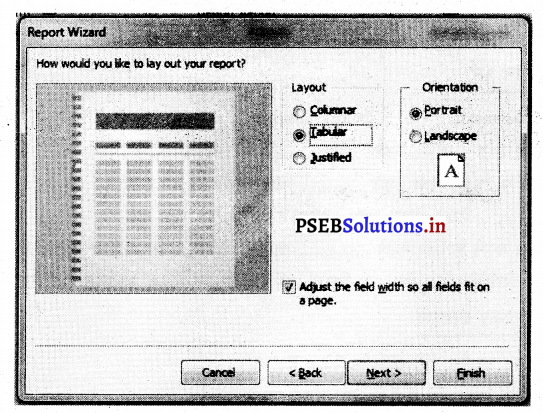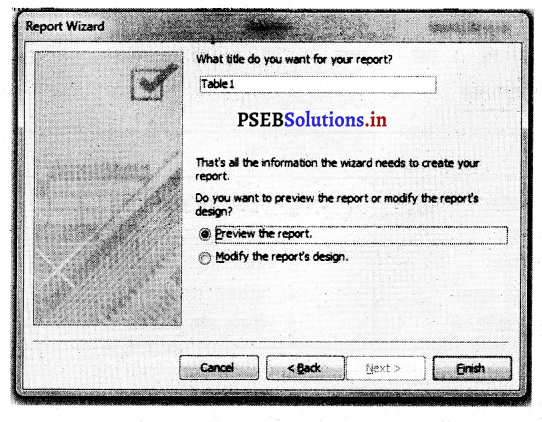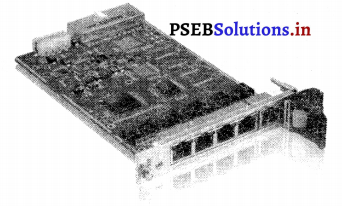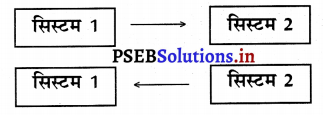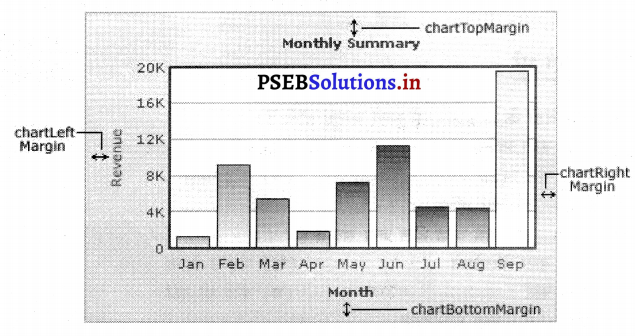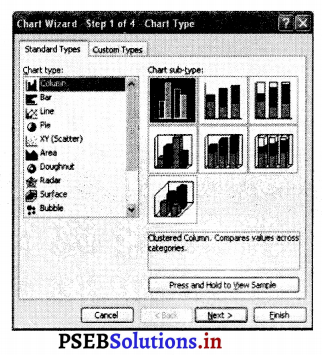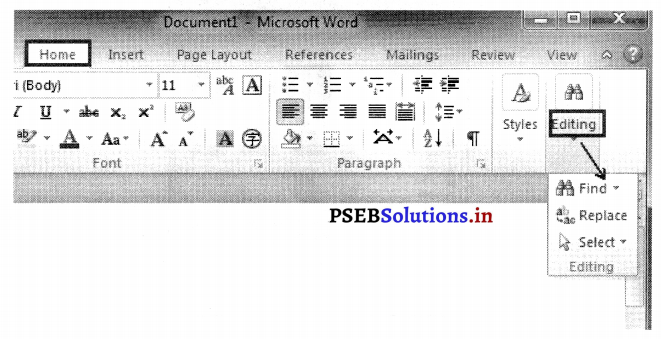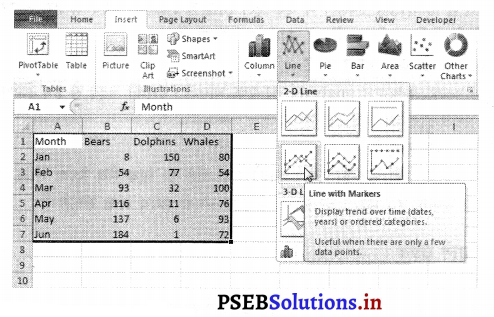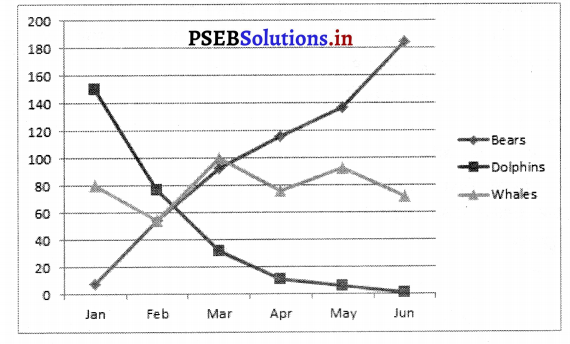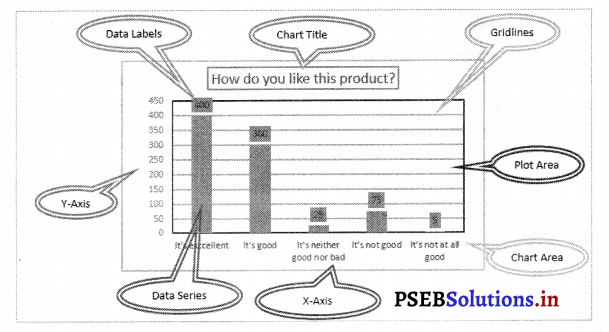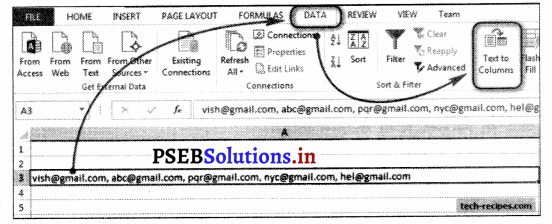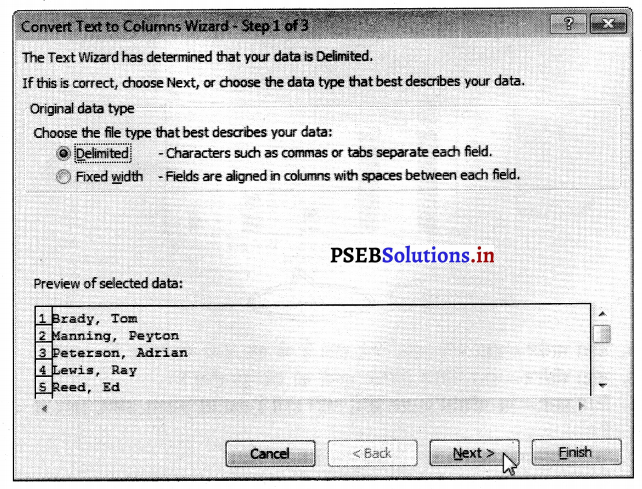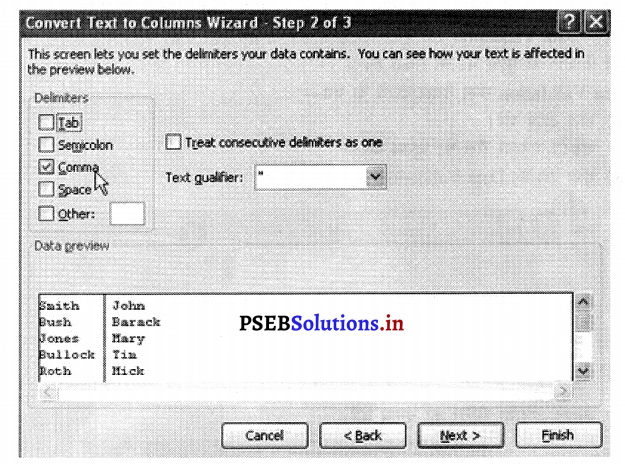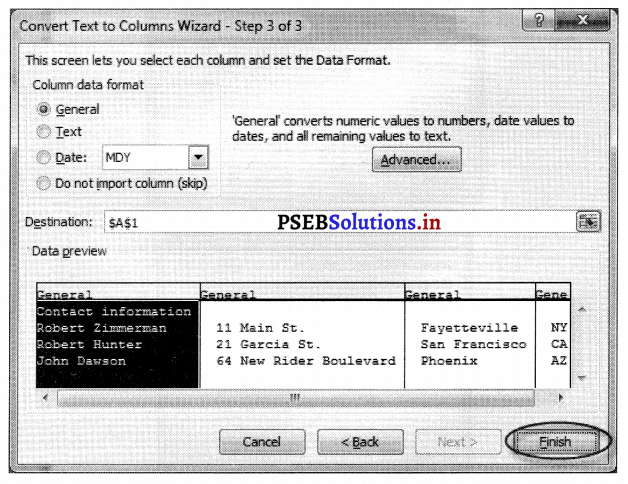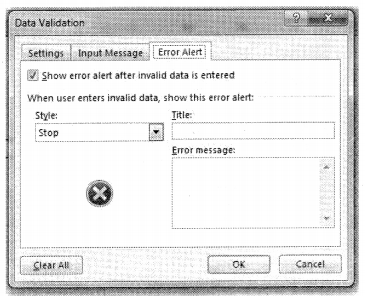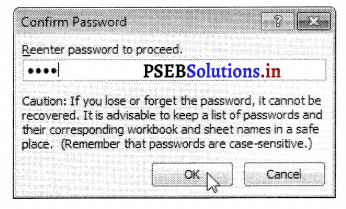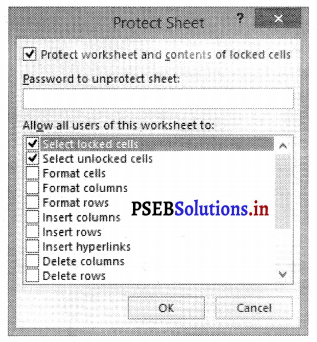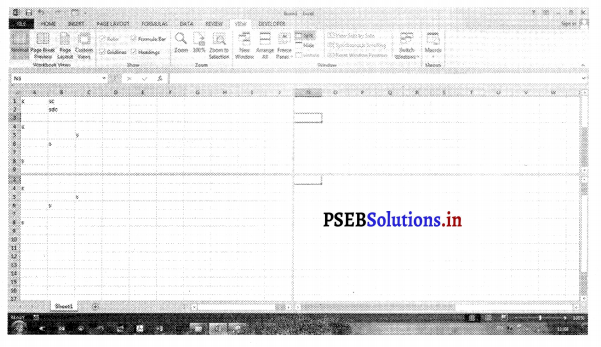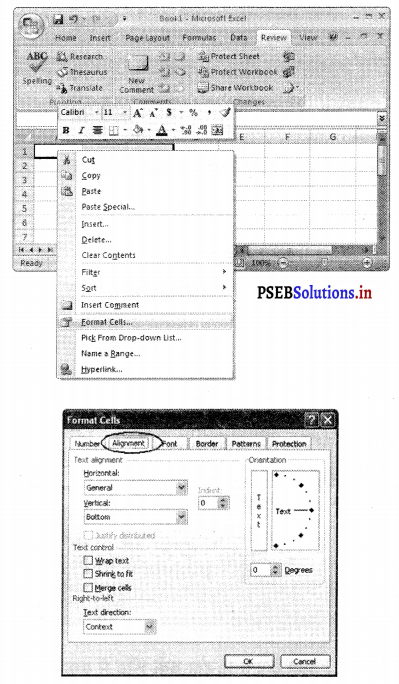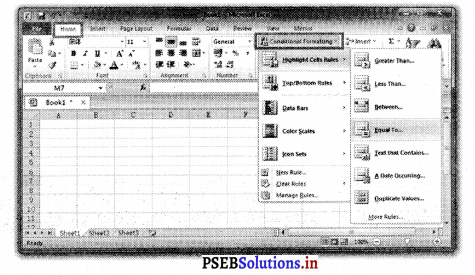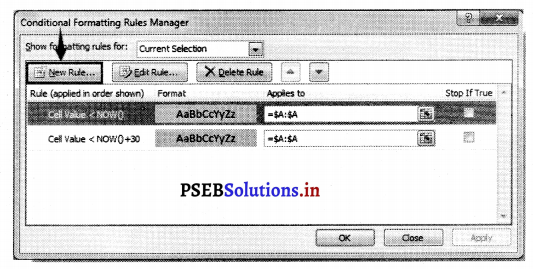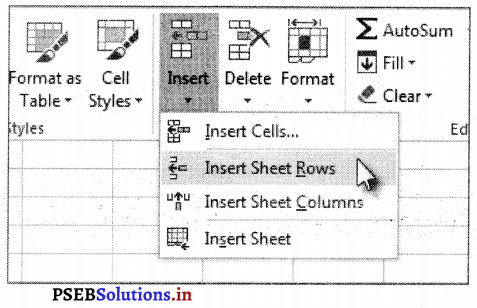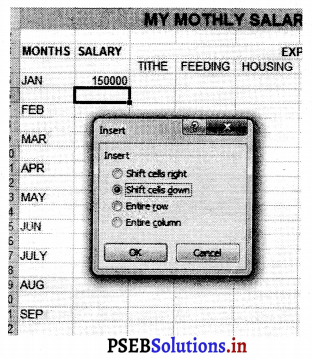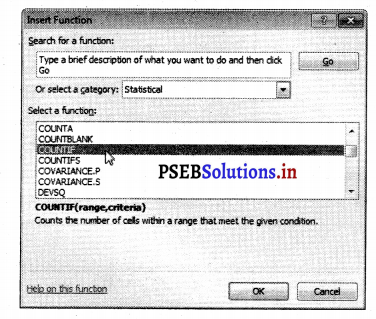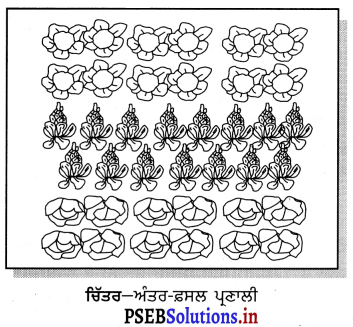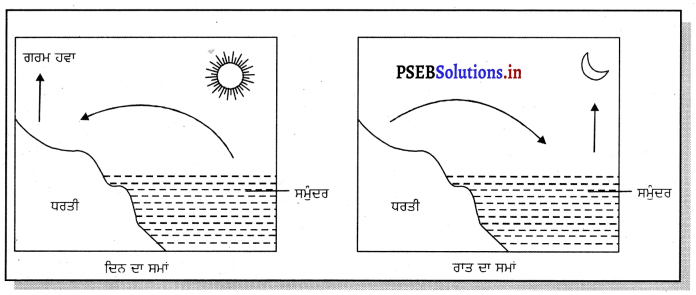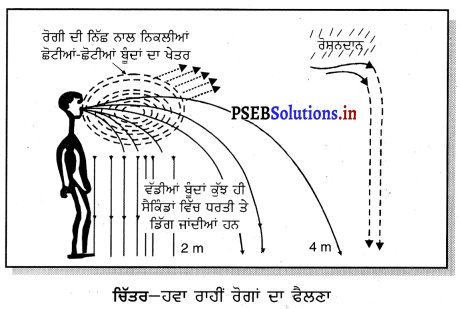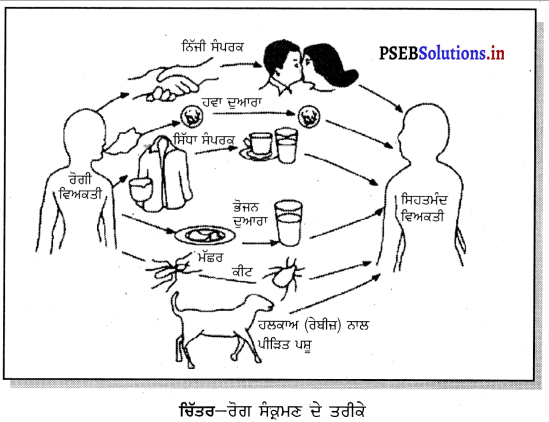Punjab State Board PSEB 9th Class Computer Book Solutions Chapter 7 ई-गवर्नेस Textbook Exercise Questions and Answers.
PSEB Solutions for Class 9 Computer Chapter 7 ई-गवर्नेस
Computer Guide for Class 9 PSEB ई-गवर्नेस Textbook Questions and Answers
1. बहुविकल्पीय प्रश्न-उत्तर
1. G2C का मतलब है-
(क) Government to Co-operation
(ख) Grievances to Co-operation
(ग) Government to Citizen
(घ) None of these.
उत्तर-
(ग) Government to Citizen.
2. G2G का मतलब है-
(क) Government to Government
(ख) Set to Go
(ग) Gather to Go
(घ) None of these.
उत्तर-
(क) Government to Government.
3. G2E का मतलब है-
(क) Grievance to employee
(ख) Government to employee
(ग) Government to environment
(घ) None of these.
उत्तर-
(ख) Government to employee
4. G2B का मतलब है-
(क) Government to Banks
(a) Government to Businessmen
(ग) Government to Business
(घ) None of these.
उत्तर-
(ख) Government to Businessmen.
5. IRCTC का मतलब है-
(क) Indian Railway Catering and Tourism Co-operation Ltd.
(ख) Indian Runway Catering and Tourism Co-operation Ltd.
(ग) Indian Railway Catering and Travelling Co-operation Ltd.
(घ) Indian Railway Cargo and Tourism Co-operation Ltd.
उत्तर-
(क) Indian Railway Catering and Tourism Co-operation Ltd.
2. छोटे उत्तर वाले प्रश्न
प्रश्न 1.
ई-गवनेस क्या हैं ?
उत्तर-
ई-गवर्नेस का मतलब है कि सरकारी सेवाओं को आनलाइन करना। सरकार के कामकाज का आनलाइन होना।
प्रश्न 2.
ई-गवर्नेस के दो उद्देश्य कौन-से हैं ?
उत्तर
- भिन्न-भिन्न आनलाइन सेवाओं का प्रयोग करके जनता की ज़रूरतों को आसानी से पूरा करना।
- सरकारी प्रशासनिक काम-काज की पारदर्शी, उत्तरदेय और प्रभावशाली तरीके के साथ सेवाओं को उपलब्ध करवाना।
प्रश्न 3.
शहरी क्षेत्र में ई-गवर्नेस के कौन-कौन से काम होते हैं ?
उत्तर
- सड़क सेवाओं के काम-काज जैसे-कच्चा आईसस बनना, गाड़ियों के टाइम-टेबल बनना।
- बिल और टैक्स को आनलाइन जमा करवाना।
- सड़क और सुरक्षा का प्रबंध करना।
प्रश्न 4.
गाँव क्षेत्र में ई-गवर्नेस कौन-कौन से काम करती है ?
उत्तर-
गाँव क्षेत्र में ई-गवर्नेस का बहुत अच्छा प्रभाव है। यहाँ पर खेती से संबंधित काम-काज से लेकर आम-सूचना के सारे काम ई-गवर्नेस ही करती है।
3. बड़े उत्तर वाले प्रश्न
प्रश्न 1.
एक अच्छी गवर्नेस की मुख्य विशेषताएं क्या हैं ?
उत्तर-
एक अच्छी गवर्नेस की मुख्य विशेषताएं निम्नलिखित हैं
- अच्छी गवर्नेस में सभी सम्मिलित होते हैं। कोई भी आदमी जोकि किसी निर्णय द्वारा प्रभावित होता है या फैसला लेने की प्रक्रिया में भाग लेना चाहता है, में शामिल हो सकता है। यह कई ढंगों से जैसे कि किसी वर्ग के लोगों को जानकारी देनी और उनकी राय का पता लगाना, उनको सिफारिशों का मौका देना या कई बार उनको वास्तव में निर्णय करने के कार्य में शामिल कर लिया जा सकता है।
- अच्छी गवर्नेस कानून का पालन करती है।
- अच्छी गवर्नेस निर्णय करने और फैसले लागू करने में प्रभावशाली और कुशल होती है और कई प्रक्रियाओं द्वारा उपलब्ध लोगों, स्रोतों के अच्छे प्रयोग करके समाज की आवश्यकता अनुसार नतीजे प्राप्त करती है।
- अच्छी गवर्नेस लिए गए फैसले के नतीजे के लिए जनता को उत्तरदायी होती है।
- अच्छी गवर्नेस जनता की आवश्यकताओं को समय पर और ठीक ढंग से पूरा करने के लिए उत्तरदायी होती है।
- अच्छी गवर्नैस पारदर्शी होती है, इससे अभिप्राय यह है कि जनता साफ-साफ यह देख सकती है कि कोई फैसला कैसे और क्यों लिया गया है।
प्रश्न 2.
ई-गवर्नेस के चार स्तंभ कौन-से हैं ?
उत्तर
- संपर्क-लोगों को सरकार की सेवाओं से जोड़ने के लिए संपर्क की आवश्यकता होती है।
- ज्ञान-ज्ञान का भाव है IT (Information Technology) का ज्ञान। सरकार अच्छे इंजीनियर को इस काम के लिए रखती है जो ई-गवर्नेस के काम को अच्छे से पूरा करते हैं।
- डाटा-इंटरनैट पर सूचना को शेयर करने के लिए सरकार अपनी सेवाओं से संबंधित डाटाबेस का रख-रखाब करती है।
- पैसा-सरकार की तरफ से अपनी सेवाओं को लागू करने के लिए लगाई गई राशि।
प्रश्न 3.
ई-गवर्नेस के चार मॉडल का विवरण करें।
उत्तर
1. सरकार से नागरिक-यह सरकार की उन सेवाओं के बारे में बताती है जो एक नागरिक प्रयोग करता है। इस मॉडल में नागरिक जिन सेवाओं का प्रयोग करना चाहते हैं, उस लिंक का प्रयोग करते हैं। इसका प्रयोग करके नागरिक आन लाइन पानी का बिल, बिजली और टैलीफोन आदि को जमा करवा सकता है।
2. सरकार से सरकार इस मॉडल में सरकार के बीच शेयर किये जाने वाली सेवाएं आती हैं। इसमें सरकार भिन्न-भिन्न प्रकार के राज्य के पुलिस विभाग शेयर किये जाने वाली सूचना और बजट से संबंधित काम शामिल है।
3. सरकार से व्यापारी-इसमें निजी क्षेत्र और सरकार के बीच रिश्ता और भी अच्छा होता है। यह व्यापारियों से सरकार और सरकार से व्यापारियों की बातचीत करने के लिए प्रयोग किया जाता है। इसमें टैक्स को इकट्ठा करना, पैकिंग वस्तुओं को मंजूर या न मंजूर करना आदि शामिल है।
4. सरकार से कर्मचारी-इस मॉडल में सरकार और इसके कर्मचारियों के बीच और अच्छे संबंधों के लिए काम करता है। इसके कर्मचारी सरकार के काम और कार्य प्रणाली की देखभाल करते हैं।
प्रश्न 4.
सेहत और शिक्षा के क्षेत्र में ई-गवर्नेस का क्या काम है ? विवरण करें।
उत्तर-
सेहत और शिक्षा के क्षेत्र में ई-गवस का बहुत महत्त्वपूर्ण योगदान है। इसमें सरकार शिक्षा के क्षेत्र और सेहत विभाग में क्या काम चल रहा है उसकी पूरी देखभाल करती है। इसमें सरकार इस बात को देखती है कि सेहत और शिक्षा के क्षेत्र में कितना सुधार हुआ है। यदि कोई सुधार हुआ है तो कितनी मात्रा में हुआ है।
प्रश्न 5.
ई-गवर्नेस का इतिहास और विकास का विवरण करें।
उत्तर-
भारत में ई-गवर्नेस 1970 में स्थापित की गई। उस समय सरकार ने इसको सुरक्षा के क्षेत्र, पैसे के लेन-देन की योजना के क्षेत्र में प्रयोग किया? सूचना और संचार टैकनोलॉजी का प्रयोग वोट, टैक्स, प्रशासन से संबंधित डाटे का प्रबंध करने के लिए किया जाता है। इसके बाद NIC-National Information Center की कोशिशों से सारे जिलों को आपस में जोड़ा गया।
साल 1990 की शुरुआत में ई-गवर्नेस ने सूचना टैकनोलॉजी का प्रयोग करके बहुत बड़े क्षेत्र में पहुंच गए और गांव क्षेत्र में पहुंचने की कोशिश की। पहले सरकार और नागरिक के बीच बात करने के लिए कार्यालय की ज़रूरत पड़ती थी। परन्तु सूचना और संचार के क्षेत्र में प्रगति आने से सरकारी काम और अच्छे तरीके से होने लगा। सूचना और संचार में ग्राहकों के लिए, सेवा केन्द्र को ढूंढना और भी संभव हो गया। यह केन्द्र सरकारी एजेंसी में ‘काऊंटर के रूप में या ग्राहकों के नजदीक सरकारी एजेंसी के बाहर भी हो सकते हैं।
PSEB 8th Class Computer Guide ई-गवर्नेस Important Questions and Answers
रिक्त स्थान भरें
1………….. से मतलब है कि सरकारी सेवाओं की ………….. .
उत्तर-
ई-गवर्नस, ऑनलाइन,
2. RSPCB का मतलब है
उत्तर-
Rajasthan State Pollution Control Board,
3. IRCTC का मतलब है ………….
उत्तर-
Indian Railway Catering and Tourism Co-operation Ltd.,
4. UIDAI से मतलब ……………..
उत्तर-
Unique Identification Authority of India,
5. HRTC का मतलब …………
उत्तर-
Himachal Road Transport Corporation Project,
6. E-Seva का भाव
उत्तर-
Electronic Seva, 6 ईगवनस,
7. सामाजिक कार्यों को करने के लिए प्रक्रियाओं के समूह को ………… कहा जाता है।
उत्तर-
सुविधा सेंटर,
8. सरकारी कार्यों को करने के लिए सरकार . ………… की प्रक्रिया का इस्तेमाल करती है।
उत्तर-
Single user Friendly Window Disposal Help line for Application,
9. सुविधा का अर्थ है ……………. ।
उत्तर-
सुविधा सेंटर,
10. एफीडेविट की तुरंत तसदीक …………….सेंटर में हो सकती है।
उत्तर-
रजिस्टरी,
11. वाहनों की ………. सुविधा सेंटर में हो सकती है।
उत्तर-
6.
12. आप …………….. में से किसी भी वक्त पैसे निकलवा सकते हैं।
उत्तर-
ATM.
सही या गलत बताइये-
1. i-tickets के प्रयोग से केवल ऑन लाइन रेलवे टिकट बुकिंग होती है।
उत्तर-
सही,
2. i-ticketing में टिकट बुकिंग 2 दिन पहले होनी जरूरी है।
उत्तर-
सही,
3. e-ticketing का प्रयोग तत्काल बुकिंग के लिए होता है।
उत्तर-
सही,
4. e-governance सुविधायें हासिल करने के लिए कम्प्यूटर का प्रयोग नहीं किया जाता।
उत्तर-
गलत,
5. ऑन लाइन बैंकिंग की मदद से एक खाते से दूसरे खाते में धन भेजना संभव है।
उत्तर-
सही,
6. i-tickets के प्रयोग से केवल ऑन लाइन रेलवे टिकट बुकिंग होती है।
उत्तर-
सही,
7. i-ticketing में टिकट बुकिंग 2 दिन पहले होनी जरूरी है।
उत्तर-
सही,
8. e-ticketing का प्रयोग तत्काल बुकिंग के लिए होता है।
उत्तर-
सही,
9. e-governance सुविधाएं हासिल करने के लिए कम्प्यूटर का प्रयोग नहीं किया जाता।
उत्तर-
गलत,
10. ऑन लाइन बैंकिंग की मदद से एक खाते से दूसरे खाते में धन भेजना संभव है।
उत्तर-
सही।
छोटे उत्तर वाले प्रश्न
प्रश्न 1.
E-Aadhar क्या है ?
उत्तर-
ई-आधार 12 अंकों का हर एक व्यक्ति के लिए पहचान नंबर है जोकि UIDAI का भारत सरकार लागू करती है। यह नंबर पूरे भारत में पहचान और पते का प्रमाण होता है।
प्रश्न 2.
आपदा प्रबंधन क्या है ?
उत्तर-
किसी भी सरकार के लिए आपदा/मुसीबत का सामना करना बहुत बड़ी बात होती है क्योंकि यह प्राकृतिक और किसी भी समय होने वाली घटना है। इस तरह की मुसीबत का सामना करने के लिए सरकार ने तथा कई राज्य सरकारों ने ई-गवर्नेस के बहुत-से क्षेत्र शुरू किये हैं।
प्रश्न 3.
ई-गवर्नेस से क्या अर्थ है?
उत्तर –
ई-गवर्नेस का अर्थ है सूचना तकनीक की मदद से नागरिकों और व्यापारियों को नई-से-नई व्यापारिक जानकारी देना और कार्यों को बढ़िया तरीके से उन को प्रदान करवाना।
प्रश्न 4.
ई-गवर्नस का प्रयोग (लाभ) बताइये।
उत्तर-
- काम खर्च
- तेज़ रफ्तार
- कभी भी किसी भी समय।
प्रश्न 5.
ई-गवनैस की सेवा कौन-कौन से क्षेत्र प्रदान करता है?
उत्तर-
- बैंकों में
- हवाई जहाज और रेलवे की टिकट बुक करवाने में
- जन्म और मौत के सर्टीफिकेट जारी करने के लिए।
प्रश्न 6.
इंटरनेट बैंकिंग से भाव है?
उत्तर-
इस बैंकिंग के द्वारा हम इंटरनैट के द्वारा आम बैंकिंग सुविधाएं जैसे कि भुगतान (Payment), मनी ट्रांसफर (Money Transfer) और अकाऊंट बकाया (Account Balance) आदि काम 24 घंटे कर सकते हैं।
प्रश्न 7.
आन लाइन रेलवे और हाई टिकटिंग से क्या भाव है?
उत्तर-
इस तकनीक के द्वारा हम रेल गाड़ियों और हवाई उड़ानों की जानकारी पहले से ही प्राप्त कर सकते हैं और रेलवे और हवाई जहाज़ की टिकटें इंटरनेट के द्वारा घर बैठे बुक करवा सकते हैं।
प्रश्न 8.
भारती रेलवे की टिकटिंग प्रणालियों के नाम लिखें।
उत्तर-
- आई-टिकटिंग (i-ticketing)
- ई-टिकटिंग (e-ticketing)।
प्रश्न 9.
सुविधा सैंटर से क्या भाव है?
उत्तर-
इन सैंटरों में जनता की आम ज़रूरत में आने वाली सेवायें, सहूलतें प्रदान की जाती हैं, जैसे कि पासपोर्ट बनाने, राशन कार्ड बनाने, विवाह की रजिस्ट्रेशन।
प्रश्न 10.
JIT से आप क्या समझते हैं ?
उत्तर-
JIT से अर्थ है Just In Time, भाव जनता को उसी समय सुविधा प्रदान करवाना जिस समय वो यह सुविधा प्राप्त करना चाहता है जैसे कि ATM मशीनों के आ जाने से व्यक्ति किसी भी समय पैसे निकाल सकता है और यह 24 घंटे खुले रहते हैं और इनको ऑपरेट करने के लिए किसी भी व्यक्ति की ज़रूरत नहीं होती।
प्रश्न 11.
i-tickting क्या होती है ?
उत्तर-
आई-टिकटिंग (i-tickting) यह मुफ्त , web baised टिकटिंग सिस्टम है। इस प्रणाली में कस्टमर (Customer) को कम-से-कम 2 दिन पहले टिकट बुक करवानी पड़ती है और 2 या 3 दिन से अंदर टिकट घर पहुँचा दी जाती है।
प्रश्न 12.
E-tickting क्या होती है ?
उत्तर-
ई-टिकटिंग (E-tickting) यह एक आन लाइन (Online) टिकट है। इस टिकट को e-mail के द्वारा भेजा जा सकता है या (Printable Online) पर प्रिंट किया जा सकता है। ई-टिकटिंग गाड़ी के समय के चार्ट से हिसाब से बुक की जाती है। ई-टिकटिंग के लिए शिनास्ति सबूत जैसे कि Voter ID कार्ड, राशनकार्ड पासपोर्ट, PAN कार्ड या ड्राईविंग लाईसेंस आदि का विवरण देना पड़ता है। इस के बाद उसका एक प्रिंट लेकर और यात्रा करते समय यह प्रिंट और अपना ID सबूत साथ रखना चाहिये।
प्रश्न 13.
E-governance का क्या महत्त्व है?
उत्तर –
- ई-गवर्नेस से कोई भी काम बड़ी तेज़ी, आसानी से कर सकते हैं। जिन कामों को बहुत ज्यादा समय लगता था, वही काम आज बड़ी आसानी और परंपरागत तरीकों से किया जा सकता है।
- इस में लिखित, मौखिक, वीडियो और ऐनीमेशन तकनीकें शामिल हैं।
- इसका खर्च परंपरागत साधनों के खर्च से बहुत कम होता है। पूरा सैट-आप स्थापित हो जाने से इसका रोज़ाना खर्चा बहुत कम होता है । सिर्फ शुरुआत के खर्चे ज्यादा हैं।
- ई-गवर्नेस की मदद से हम भी कहीं भी किसी भी टाईम अपना काम कर सकते हैं जैसे हम किसी भी बैंक की वैब साईट से अपने अकाऊंट की जानकारी प्राप्त कर सकते हैं और बैंकों की नई स्कीमों की जानकारी प्राप्त कर सकते हैं।
प्रश्न 14.
सुविधा सैंटरों के कोई पाँच मुख्य उपयोगों का वर्णन करें ।
उत्तर-
- इन सैंटरों में जनता की आम ज़रूरत में आने वाली सेवायें, सहूलतें प्रदान की जाती हैं।
- हर सुविधा सैंटर में हैल्प-लाईन नंबर मौजूद हैं। कोई भी व्यक्ति टेलीफोन करके ज़रूरी जानकारी प्राप्त कर सकता है।
- सेवाओं के लिए एक स्थान पर सारी ऐपलीकेशनज़ को जमा करवाना ।
- जो भी नई स्कीम या तरीका हो उसकी जानकारी मौके पर उसी समय ही उपलब्ध हो जाती है।
- सुविधा केंद्रों की कोरीयर (Courier) सर्विस भी बहुत तेज़ है जिस के द्वारा ज़रूरी कागजात अब 48 घंटों में व्यक्तियों के घर पहुंचा दिये जाते हैं।
